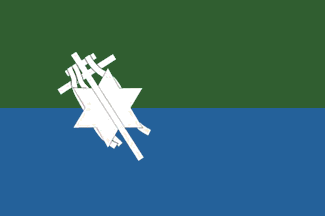 klaus-michael schneider
klaus-michael schneider
Keywords: carabobo | san joaquin |
Links: FOTW homepage | search | disclaimer and copyright | write us | mirrors

FOTW beschäftigt sich mit der Wissenschaft der Vexillologie (Flaggenkunde).
Alle auf dieser Website dargebotenen Abbildungen dienen ausschließlich der Informationsvermittlung im Sinne der Flaggenkunde.
Wir distanziert uns ausdrücklich von allen hierauf dargestellten Symbolen verfassungsfeindlicher Organisationen.
Last modified: 2021-08-26 by  klaus-michael schneider
klaus-michael schneider
Keywords: carabobo | san joaquin |
Links: FOTW homepage |
search |
disclaimer and copyright |
write us |
mirrors
 image by Luis Manuel Lopez Rojas, 18 April 2020
image by Luis Manuel Lopez Rojas, 18 April 2020
See also:
The flag of San Joaquín Municipality is official Since October 14, 2015.
Green represents the geographical location to the north, its mountains,
vegetation, hills and mountains that unite and limit us
with the Coastal
Range.
Blue represents the location to the south, limited and connected
to Lake Tacarigua or Valencia, represents this expanse of water as a mirror of
our sky that covers horizontally from beginning to end of the municipality; and
our rivers as a hydrographic source with the emblematic Ereigüe River (formerly
called Hato Viejo) recreational and tourist potential of the San Joaquín
municipality.
Between the green and blue stripe are the emblems of the
star and gajillo of our maximum cultural representation of the Shepherds of San
Joaquin, whose figurative shapes it represents: the six-pointed star
representative of the star guide of our Shepherds of San Joaquin, represents our
populated center, its autonomy, its people; his nobility and ingenuity, forgers
of one of the fourteen municipalities of the Carabobo state that, like the
stars, shines with its own light. The gajillo of figurative form of musical
instrument, of the dance of the Shepherds and Little Shepherds of San Joaquín.
Luis Manuel Lopez Rojas, 18 April 2020
These are extracts of the Municipal Ordinance:
Article 3.https://fr.scribd.com/document/397385991/Ordenanza-Simbolos-del-Municpio-san-Joaquin-Carabobo
The flag of the municipality of San Joaquín, created by José Ramón Castillo Peraza, was selected in a public open competition sanctioned by a popular, universal, direct and secret vote held on 4 and 5 July 2014.
The winning design was technically fitted by Lic. Carlos Zambrano, matching the following description.
Symbology.
Attributes: Composed of a rectangular panel divided into two horizontal stripes of equal size, green in the upper part and blue in the lower part. Over the stripes a six-pointed white star and a "gajillo" of the same diagonally superimposed to the star.
Semiology.
The green stripe represents the northern part of the municipality, its mountains, vegetation and the hills that unit it and form its limit with Cordillera de la Costa.
The blue stripe represents the southern part of the municipality, united and limited by Lake Tacarigua (Valencia), representing the lake as a reflect of the sky that horizontally covers our municipality from the beginning to the end. It also represents rivers as hydrographical resources, namely emblematic river Ereigüe (once known as Hato Viejo), the recreation and tourism potential of the municipality of San Joaquín
Over the green and blue stars are placed, in white, the star and the gajillo, the highest cultural representation of the Pastores de San Joaquín:
- the six-pointed star represents the guide for the San Joaquín Shepherds, the urban nucleus, its autonomy and people, their nobleness and ingeniousness as the builders of one of the 14 municipalities in Carabobo State, which, like the stars, shine with proper light.
- the "gajillo", the figurative form of the music instrument played in the dances of the San Joaquín Shepherds, is a religious, cultural and historic icon of the devotion to Baby Jesus, the pride of San Joaquín's identity.
§1. The Pantone color specifications are composed of 8 basic colors, starting with the municipal colors (San Joaquín blue and San Joaquín green), Pantone 293cv and 357cv, respectively.[...]
Hosted by: Fanshop-Online.de und Handy-Shop.de
Tipp: Apple iPhone 12 im Shop